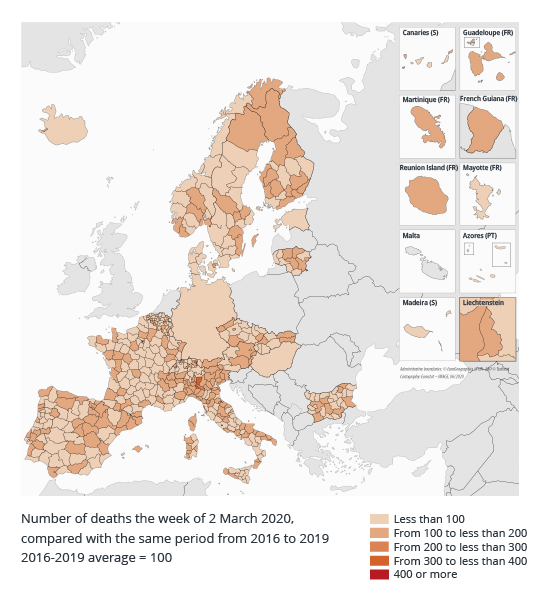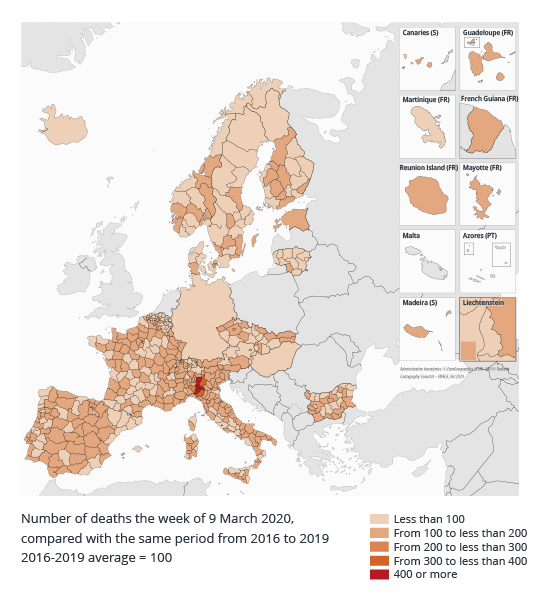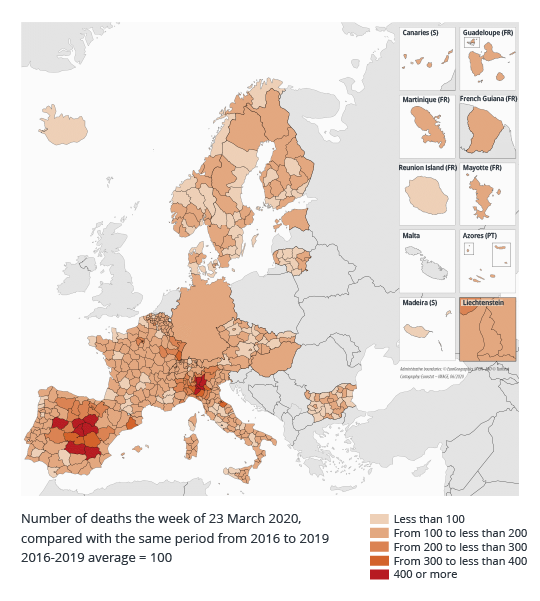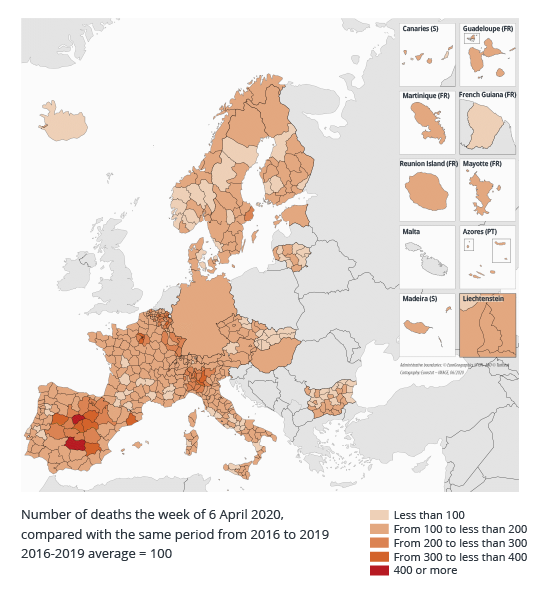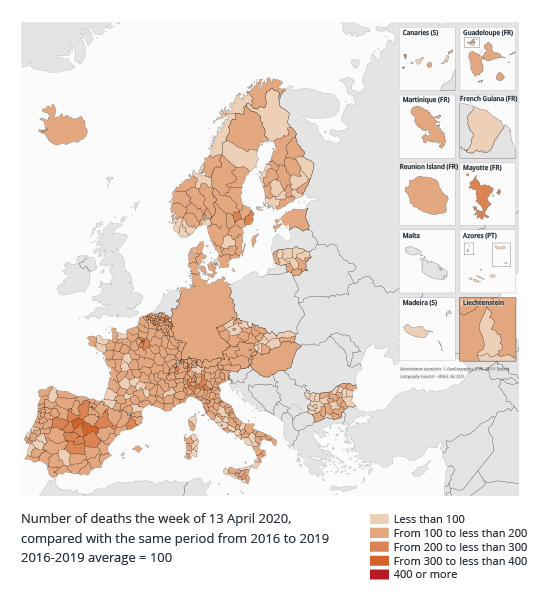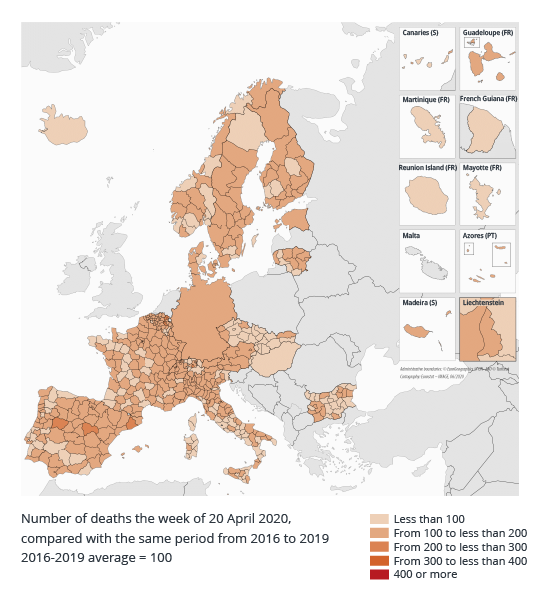 In France, like in Europe, an excess mortality linked to COVID-19 occured in late
March/early April
In France, like in Europe, an excess mortality linked to COVID-19 occured in late
March/early April
In France, as in Europe, the peak in excess mortality linked to COVID-19 occured during the week of 30 March 2020. Between 2 March and 26 April, the excess deaths from all causes, compared with the 2016-2019 average, were a little higher in France than in Europe, although still below the levels of Spain, Italy and Belgium.
These excess deaths were slightly more prevalent among men and followed a different timescale. In France, as in Europe, people aged 70 and over were the most affected.
In France, between 2 March and 26 April 2020, the level of excess mortality compared with the 2016-2019 average stood between 100% and 150% in five departments (Haut-Rhin, Hauts-de-Seine, Seine-Saint-Denis, Val-de-Marne and Val-d'Oise). Several Spanish and Italian provinces recorded an excess mortality of above 150%.
This publication is based on data on weekly deaths collected by Eurostat from European National Statistical Institutes.
Same trend in deaths in France and in Europe over the first four months of 2020
The gap between deaths from all causes during the first four months of 2020 and the average for the same period between 2016 and 2019 followed a similar trend in France as in 21 European countries considered as a whole (sources). Over the first few weeks of 2020, until the end of February, mortality was generally lower than the average from 2016 to 2019. This is explained, in particular, by the fact that seasonal flu resulted in almost no excess deaths in Europe at the beginning of this year. Although, the number of deaths usually began to drop from the start of March in previous years, it instead rose significantly in 2020, reaching a peak in both France and Europe during the week of 30 March 2020. During that week, excess deaths reached 50% in Europe, i.e. there were 50% more deaths than in the same average week between 2016 and 2019 (Figure 1). It exceeded 60% in France and reached 155% in Spain, 91% in Belgium (where it would go on to reach 107% in the week beginning on 6 April) and 67% in Italy (falling from 88% the week before, as Italy saw its peak one week earlier). It then fell gradually and had almost disappeared by the start of May.
tableauFigure 1a - Number of weekly deaths in France and in 21 European countries from 1 January to 10 May 2020, compared with the same week from 2016 to 2019
| Week of | Europe | France |
|---|---|---|
| 1 January | 91,5 | 93,5 |
| 6 January | 94,8 | 96,4 |
| 13 January | 94,5 | 94,5 |
| 20 January | 94,4 | 93,6 |
| 27 January | 96,4 | 96,1 |
| 3 February | 94,7 | 95,5 |
| 10 February | 96,2 | 97,2 |
| 17 February | 93,3 | 94,5 |
| 24 February | 93,5 | 94,2 |
| 2 March | 97,2 | 96,8 |
| 9 March | 106,8 | 104,4 |
| 16 March | 123,4 | 118,3 |
| 23 March | 139,9 | 137,9 |
| 30 March | 147,8 | 162,8 |
| 6 April | 141,6 | 155,9 |
| 13 April | 128,4 | 138,0 |
| 20 April | 114,8 | 116,0 |
| 27 April | 106,6 | 103,6 |
| 4 May | 104,3 | 102,6 |
- Note: The data for 2020 are provisional. The data for the week of 4 May for Slovakia and for the weeks of 27 April and 4 May for the Czech Republic and Luxembourg are estimated. Data are missing for each year for Italy (13% of municipalities missing) and for Sweden (week of death not known).
- Reading note: In the week of 30 March 2020, deaths in France and Europe were 63% and 48% higher than the 2016-2019 average, respectively.
- Coverage: 21 European countries, 17 of which are European Union members and 4 from the European Free Trade Association.
- Sources: Eurostat, data extracted on 9 July 2020; calculations by INSEE.
graphiqueFigure 1a - Number of weekly deaths in France and in 21 European countries from 1 January to 10 May 2020, compared with the same week from 2016 to 2019

- Note: The data for 2020 are provisional. The data for the week of 4 May for Slovakia and for the weeks of 27 April and 4 May for the Czech Republic and Luxembourg are estimated. Data are missing for each year for Italy (13% of municipalities missing) and for Sweden (week of death not known).
- Reading note: In the week of 30 March 2020, deaths in France and Europe were 63% and 48% higher than the 2016-2019 average, respectively.
- Coverage: 21 European countries, 17 of which are European Union members and 4 from the European Free Trade Association.
- Sources: Eurostat, data extracted on 9 July 2020; calculations by INSEE.
Significant disparities between countries and at sub-national levels
The level of over-mortality varied greatly accross European countries. Between 2 March and 26 April 2020, the vast majority (84%) of excess deaths observed in the 21 European countries can be attributed to Spain, Italy and France (Figure 2), with the share attributable to these counties reaching almost twice their usual share in overall deaths (44% for the same period between 2016 and 2019). Excess mortality in Spain, Italy, Belgium and France reached respectively 71%, 49%, 44% and 28% over the eight weeks from 2 March to 26 April. Conversely, in Germany, Europe’s most populous nation, over-mortality was significantly lower (4% over the same period). This is also the case in countries of Central and Eastern Europe.
tableauFigure 2 - Differences in weekly deaths in 21 European countries from 2 March to 26 April 2020 compared with the same week from 2016 to 2019, by country
| Week of | Spain | Italy | France | Germany | Belgium | Other countries | Total |
|---|---|---|---|---|---|---|---|
| 2 March | – 13 | 1 140 | – 407 | – 1 715 | – 246 | – 958 | – 2 199 |
| 9 March | 840 | 4 945 | 537 | – 651 | – 116 | – 460 | 5 095 |
| 16 March | 4 462 | 8 988 | 2 195 | 88 | 237 | 1 104 | 17 074 |
| 23 March | 10 942 | 10 286 | 4 507 | 680 | 961 | 1 293 | 28 669 |
| 30 March | 12 545 | 7 669 | 7 327 | 2 076 | 1 908 | 2 217 | 33 742 |
| 6 April | 9 214 | 6 019 | 6 357 | 2 499 | 2 211 | 2 408 | 28 708 |
| 13 April | 5 348 | 4 082 | 4 300 | 1 802 | 1 670 | 1 945 | 19 147 |
| 20 April | 2 678 | 2 230 | 1 795 | 994 | 1 005 | 1 206 | 9 908 |
- Note: The data for 2020 are provisional. The data are missing for each year for Italy (13% of municipalities missing).
- Reading note: In the week of 30 March 2020, there were 33,700 excess deaths in Europe compared with the 2016-2019 average, 82% of which occurred in three countries (Spain, France and Italy).
- Coverage: 21 European countries, 17 of which are European Union members and 4 from the European Free Trade Association.
- Sources: Eurostat, data extracted on 9 July 2020; calculations by INSEE.
graphiqueFigure 2 - Differences in weekly deaths in 21 European countries from 2 March to 26 April 2020 compared with the same week from 2016 to 2019, by country

- Note: The data for 2020 are provisional. The data are missing for each year for Italy (13% of municipalities missing).
- Reading note: In the week of 30 March 2020, there were 33,700 excess deaths in Europe compared with the 2016-2019 average, 82% of which occurred in three countries (Spain, France and Italy).
- Coverage: 21 European countries, 17 of which are European Union members and 4 from the European Free Trade Association.
- Sources: Eurostat, data extracted on 9 July 2020; calculations by INSEE.
The disparities are also significant at sub-national level (Figure 3). Over-mortality was particularly high in central Spain and northern Italy. In the worst-hit provinces of Spain (Ciudad Real, Guadalajara, Madrid and Segovia) and Italy (Bergamo, Brescia, Cremona, Lodi and Piacenza), the number of deaths recorded between 2 March and 26 April 2020 was over three times higher (i.e. over 200% more deaths) than over the same period average between 2016 and 2019.
In Metropolitan France, in the five most affected departments (Haut-Rhin, Hauts-de-Seine, Seine-Saint-Denis, Val-de-Marne and Val-d'Oise), the increase was a little lower than in the provinces of the other European countries mentioned above, rising by between 100% and 150% relative to the same period average between 2016 and 2019. Conversely, Metropolitan France's Atlantic coast includes departments (Finistère and Landes) that recorded a drop in the number of deaths in 2020 compared with the 2016-2019 average. The south-west part of the Italian Peninsula also falls into this category (provinces of Roma and Latina in particular).
tableauFigure 3a – Number of deaths from 2 March to 26 April 2020, compared with the same period from 2016 to 2019
| The data are available in the file for download. |
graphiqueFigure 3a – Number of deaths from 2 March to 26 April 2020, compared with the same period from 2016 to 2019
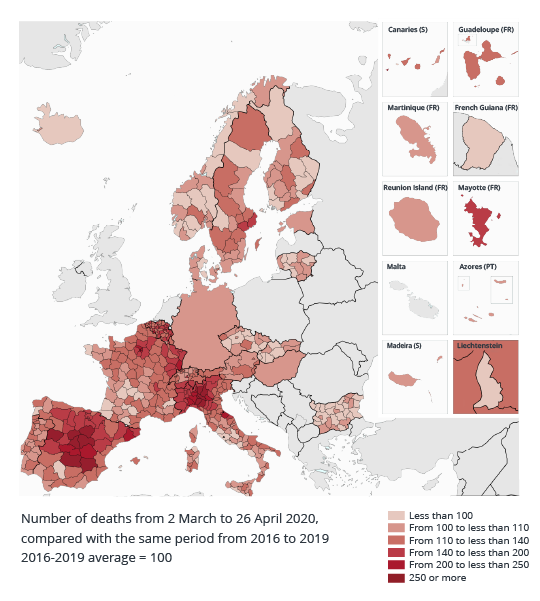
- Note: The data for 2020 are provisional.
- Reading note: Between 2 March and 26 April 2020, there were 219% more deaths than the 2016-2019 average in the province of Madrid, Spain.
- Sources: Eurostat, data extracted on 9 July 2020; calculations by INSEE.
Over-mortality slightly higher among men than among women
For the period between 2 March and 26 April 2020, in Europe and in France to a lesser extent, these excess deaths affected men slightly more than women (with a gap of + 7% and + 3% across this period, respectively). Furthermore, the timescale was slightly different in France (Figure 4a), with greater differences at European level (Figure 4b), and the acceleration in deaths up to 30 March (the peak of the epidemic) was seen primarily among men. The male/female death ratio in France reached a peak of 1.07 over the last week of March (i.e. one week before the peak in mortality) and 1.06 in Europe. In Europe, the situation reversed from the start of April, from which point more excess mortality was seen among women than men. The male/female death ratio fell to its lowest level in the week of 13 April, before returning to a threshold of around 1 in France and a little below 1 in Europe.
tableauFigure 4a - Number of weekly deaths among men and women from 2 March to 26 April 2020, compared with the same week from 2016 to 2019 and male/female death ratio in France
| Week of | Men | Women | Male/female death ratio |
|---|---|---|---|
| 2 March | 99,4 | 94,3 | 1,02 |
| 9 March | 105,6 | 103,2 | 0,99 |
| 16 March | 118,4 | 118,3 | 0,99 |
| 23 March | 144,3 | 131,7 | 1,07 |
| 30 March | 164,7 | 160,9 | 1,02 |
| 6 April | 153,6 | 158,1 | 0,97 |
| 13 April | 132,2 | 143,9 | 0,92 |
| 20 April | 115,2 | 116,9 | 0,99 |
- Note: The data for 2020 are provisional.
- Reading note: In the week of 23 March 2020, the male/female death ratio rose to 1.07 in France. The deaths among men and women were 44% and 32% higher than the 2016-2019 average, respectively.
- Coverage: France.
- Sources: Eurostat, data extracted on 9 July 2020; calculations by INSEE.
graphiqueFigure 4a - Number of weekly deaths among men and women from 2 March to 26 April 2020, compared with the same week from 2016 to 2019 and male/female death ratio in France

- Note: The data for 2020 are provisional.
- Reading note: In the week of 23 March 2020, the male/female death ratio rose to 1.07 in France. The deaths among men and women were 44% and 32% higher than the 2016-2019 average, respectively.
- Coverage: France.
- Sources: Eurostat, data extracted on 9 July 2020; calculations by INSEE.
Older people more affected
Between 2 March and 26 April 2020, the increase in mortality was observed to be more prevalent among people aged 50 and above, both in France and in Europe. For both men and women, this excess mortality was more particularly prevalent, in France and in Europe, among people aged 70 and over (59% of whom were women, both in France and Europe). In France, the excess mortality was over 40% higher among men and almost 35% higher among women in the 70-74 and 90+ age groups compared with the 2016-2019 average (Figure 5). In Europe, for both men and women, this excess mortality was highest among those aged 90 or above (1% of the total population, of whom 73% are women), where it reached 50% among men and 43% among women.
Differences between European countries difficult to explain
This descriptive study highlights a certain number of similarities among European countries, including France, in terms of the trend in deaths observed over the first few weeks of 2020, with a peak in excess deaths linked to the COVID-19 epidemic recorded almost simultaneously in late March/early April. Likewise, excess mortality varied significantly by age groups, with the elders being most hit in France and in Europe. However, beyond these similarities, there are various marked differences in excess mortality accross countries and between departments and provinces within each country. Although several factors could explain these differences, we are not yet able to explain the relative significance of each one: differences in age structures and population density; differences in health status and access to health care; existence of clusters that emerged sometimes accidentally; different dates and terms of containment and easing across countries; number of key workers and terms for conducting professional activities over the period in question, etc.
tableauFigure 5a - Number of deaths among men from 2 March to 26 April 2020, compared with the same week from 2016 to 2019 by age group
| Europe | France | |
|---|---|---|
| Aged 49 or under | 95,4 | 100,0 |
| Aged 50-54 | 106,5 | 106,4 |
| Aged 55-59 | 109,9 | 103,4 |
| Aged 60-64 | 113,6 | 110,1 |
| Aged 65-69 | 118,9 | 114,5 |
| Aged 70-74 | 138,2 | 140,5 |
| Aged 75-79 | 139,7 | 134,8 |
| Aged 80-84 | 139,2 | 127,1 |
| Aged 85-89 | 142,9 | 135,0 |
| Aged 90 or over | 149,6 | 142,3 |
- Note: The data for 2020 are provisional.
- Reading note: Between 2 March and 26 April 2020, deaths among men aged 90 or over in France and Europe were 42% and 50% higher than the 2016-2019 average, respectively.
- Coverage: 20 European countries, 16 of which are European Union members and 4 from the European Free Trade Association (Germany not included from the group of 21 countries).
- Sources: Eurostat, data extracted on 9 July 2020; calculations by INSEE.
graphiqueFigure 5a - Number of deaths among men from 2 March to 26 April 2020, compared with the same week from 2016 to 2019 by age group

- Note: The data for 2020 are provisional.
- Reading note: Between 2 March and 26 April 2020, deaths among men aged 90 or over in France and Europe were 42% and 50% higher than the 2016-2019 average, respectively.
- Coverage: 20 European countries, 16 of which are European Union members and 4 from the European Free Trade Association (Germany not included from the group of 21 countries).
- Sources: Eurostat, data extracted on 9 July 2020; calculations by INSEE.
Sources
Eurostat has collected weekly data on deaths from the statistical authorities of the European nations on a voluntary basis. These data were used in an initial publication by Eurostat on 24 June 2020, which is based on data submitted by 21 countries for the period 2016 to 2020: Austria, Belgium, Bulgaria, Czech Republic, Denmark, Estonia, Finland, France, Germany, Hungary, Iceland, Italy, Liechtenstein, Lithuania, Luxembourg, Norway, Portugal, Slovakia, Spain, Sweden and Switzerland. These countries submitted data broken down by sex, age and place of residence or place of death (using NUTS 3, territorial breakdown of the European Economic Area corresponding to departments for France, administrative arrondissements for Belgium and provinces for Spain and Italy) where available; several countries, including Germany, did not provide sub-national data. In the case of France, INSEE sends the data from the deaths recorded in the civil register. The data do not inform on cause of death; they are data for deaths from all causes.
According to the European Centre for Disease Prevention and Control (ECDC), the 21 countries covered in this analysis recorded over 90% of the deaths due to COVID-19 in the European Union (EU) and the countries of the European Free Trade Association (EFTA), excluding Switzerland. They account for 78% of the population and 77% of deaths in the EU and EFTA in 2018. Furthermore, the data for 2020 are provisional.
The Eurostat publication of 24 June 2020 was used as a basis for our analysis. However, the data used here were extracted from Eurostat’s online database on 9 July and may therefore differ slightly from those used for that publication.
The weekly deaths recorded in 2020 are compared to an average week during the reference period from 2016 to 2019.
Learn more
Number of daily deaths - France, regions and departments, Insee.
Papon S., Robert-Bobée I., “Une hausse des décès deux fois plus forte pour les personnes nées à l’étranger que pour celles nées en France en mars-avril 2020” [An increase in deaths twice as high among people born outside France than people born in France in March-April 2020], Insee Focus No. 198, July 2020.
“Ouvrir dans un nouvel ongletWeekly Death Statistics“, Eurostat, June 2020.
Gascard N., Kauffmann B., Labosse A., “26 % de décès supplémentaires entre début mars et mi-avril 2020 : les communes denses sont les plus touchées“ [26% excess deaths between early-March and mid-April 2020: densely-populated communes the most affected], Insee Focus No. 191, May 2020.



